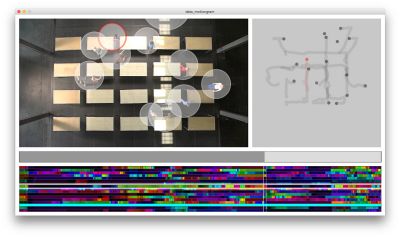| (3 intermediate revisions by the same user not shown) | |||
| Line 76: | Line 76: | ||
* Mikko Harju: [https://gist.github.com/mharju/3805082 Unknown Pleasures visualization test with Processing] (2011) | * Mikko Harju: [https://gist.github.com/mharju/3805082 Unknown Pleasures visualization test with Processing] (2011) | ||
----- | |||
== The Meandering Mind == | == The Meandering Mind == | ||
{{ | |||
[[File:Motiongram_Explorer.jpg|400px|thumb|left|Martin Schneider: [https://github.com/bitcraftlab/motion-maps/ MotionGram Explorer]]] | |||
<br style="clear:both;"> | |||
=== About === | |||
In this lecture we will have look at electric, mechanic, and biological systems and how their trajectories can be analyzed | |||
using data visualisation and sonification. | |||
=== Goals === | |||
* motiongrams and motionmaps | |||
* working with EEG, EKG, EMG data | |||
* quantified self | |||
=== Literature === | |||
{{note|Here's some literature that may be relevant for students taking the project module of Ursula Damm:}} | |||
* Edwin R. Lewis: [https://people.eecs.berkeley.edu/~lewis/ProcIEEE68.pdf Using electronic circuits to model simple neuroelectric interactions] (1968) | |||
* Stafford Beer: [https://monoskop.org/images/e/e3/Beer_Stafford_Designing_Freedom.pdf Designing Freedom] (1973) | |||
* Peter Cariani: [http://www.cariani.com/CarianiNewWebsite/Publications_files/PaskDevice93-SelfOrganizingSystems.pdf To evolve an ear: epistemological implications of Gordon Pask's electrochemical devices] (1993) | |||
Latest revision as of 21:53, 16 September 2016
Meandering Media
Meandering Sound

Martin Schneider: Vignette Explorer (2010)
About
In this lecture we will look at sound signals as meandering curves in time.
- Mathematical Functions — in the 1st part, we will learn how to create curves using mathematical functions.
- Curves of Sound — in the 2nd part, we will learn how to make audible curves in time and space.
Goals
- Basics of mathematical functions
- Polar coordinates
- Harmonic synthesizer
- Sound synthesis in Processing
Literature
- Irvine Whitty: The Harmonograph (1893)
- Joseph Goold: Harmonic Vibrations (1910)
- Tom Greenslade: All about Lissajous Figures (1993)
- Frank A. Farris: Wheels on Wheels on Wheels — Surprising Symmetry (1996)
- Aatish Bhatia: The Math Trick behind MP3s, JPEGs and Homer Simpson's Face (2013)
- Michael Trott: Making Formulas for Everyhing — from Pi to the Pink Panther to Sir Isaac Newton (2013)
- Michael Trott: Using Formulas for Everything — from a Complex Analysis Class to Political Cartoons to Music Album Covers (2013)
Code
- Santiago Ginnobili: Ptolemy and Homer Simpson (2008)
- Martin Schneider: Vignette Explorer (2011)
- Joe Freedman: Cycloid Drawing Machine + Code (2015)
Art
- Steffen Fiedler: Unreliable Machinery (2011)
- Jeroboam Fenderson: Nuclear Black Noise (2013)
Links
- Harmonic Synthsizer and Harmonic Analyser
- Michael McCarthy: Fourier-Curve Tracing the Batman-Curve (2015)
- John Baez and Anita Chodry: The Harmonograph (2016)
- Jeroboam Fenderson: Oscilloscope Music (2016)
Meandering Video
About
In this lecture will consider look at video signals as meandering curves through space and time.
Goals
- video recording technology
- introduction to video art
- scan line algorithms
- functional video transformations
- processing videos with Processing
Literature
- Thomas Dreher: Geschichte der Computerkunst: Videokulturen (2015)
- Jen Christiansen: Pop Culture Pulsar: Origin Story of Joy Division’s Unknown Pleasures Album Cover (2015)
Art
- Rutt-Etra Video Synthesizer (1974)
- Steina and Woody Vasulka: Objects (1978)
- Steina and Woody Vasulka: Transformations (1978)
Code
- Felix Turner: Rutt-Etra-Izer (2011)
- Mikko Harju: Unknown Pleasures visualization test with Processing (2011)
The Meandering Mind

Martin Schneider: MotionGram Explorer
About
In this lecture we will have look at electric, mechanic, and biological systems and how their trajectories can be analyzed using data visualisation and sonification.
Goals
- motiongrams and motionmaps
- working with EEG, EKG, EMG data
- quantified self
Literature
Here's some literature that may be relevant for students taking the project module of Ursula Damm:
- Edwin R. Lewis: Using electronic circuits to model simple neuroelectric interactions (1968)
- Stafford Beer: Designing Freedom (1973)
- Peter Cariani: To evolve an ear: epistemological implications of Gordon Pask's electrochemical devices (1993)